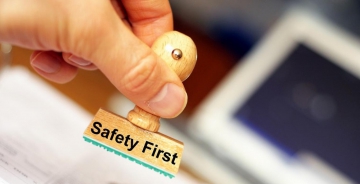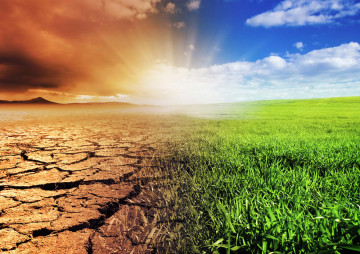- United States
- Building Business Resiliency Through Environment, Health, and Safety
Building Business Resiliency Through Environment, Health, and Safety
In today’s world uncertainty is everywhere. From the business landscape to the economy to climate change, we’re constantly managing changes, overcoming obstacles, and facing the unknown. As a business leader, building resilience is paramount to the success of your organization.
In This Guide to Building Business Resiliency You'll Find:
Going Beyond Compliance
As the workplace continues to shift and evolve, environmental, health and safety (EHS) compliance isn’t the sole concern of most businesses—it’s just one part of running a healthy and productive company. But compliance is still an absolute must in order to run a safe and effective business, and EHS managers are faced with the daunting task of managing regulatory compliance across multiple facilities and functions, often without a lot of resources and now likely virtual in some capacity.
Check in with your organization’s environmental regulatory compliance status. Companies no longer have the benefit of enforcement discretion when operational interruptions caused by the COVID-19 pandemic affect the organization’s ability to comply with environmental regulations. Download our 2022 list of environmental regulatory topics and reminders on associated compliance obligations:
While the United States Environmental Protection Agency (EPA) initially granted some latitude for enforcement discretion with companies having pandemic-related struggles while trying to comply with applicable environmental regulations, that honeymoon period has ended. Companies no longer have the benefit of enforcement discretion when operational interruptions caused by the COVID-19 pandemic affect the organization’s ability to comply with environmental regulations. What better time to check in with your organization’s environmental regulatory compliance status?
Download our Environmental Compliance Checklist
3 Stressors That Will Knock You Off Your Compliance Track
Staying on track with compliance can be a daunting task and can become more stressful should there be a change in personnel, lack of resources, or if you’re part of an acquisition. Identifying a process or management system to help track and keep track of applicable regulatory requirements is a great place to start. With everything going on in the world that requires attention, it is important to understand your options and the resources available to relieve these stressors in order for you to stay on your compliance track.
- Personnel Changes: Turnover can cause stress in any organization. If the person that leaves, is the only person with EHS knowledge of a facility, program, permit, etc., it can cause headaches for not only the facility manager but corporate managers as well. Your EHS recordkeeping and management system must be effective and up to date at the facility level to relieve some of the stress of a key EHS person leaving the organization.
- Lack of Resources: Maintaining full facility EHS compliance related to license or permit requirements is a daunting task that requires the necessary resources, consistent efforts, support, and collaboration not only from management but everyone in the organization. It is common to see a sizable facility staffed with a single EHS resource to manage all EHS-related tasks or an EHS Manager who is responsible for several facilities.
- Integration of Companies & Processes After an Acquisition: The third stressor that can knock an organization of their compliance track is when one goes through an acquisition and an integration of the companies, along with their processes (or lack thereof), must occur. If you’ve acquired an organization whose compliance record is less than stellar, where do you start? Conducting a basic gap analysis or assessment to understand compliance gaps can help an organization identify risk and know where to focus their efforts to ensure compliance and begin to integrate their own company policies.
What Happens if I Don't Comply with EHS Requirements?
There are a number of consequences for failure to comply with any and all regulations that impact your business.
- Costly fines. The actual fine can be just the tip of the iceberg. Attorney and consultant fees, along with employee hours used to focus on the noncompliance, can far outstrip the cost of the fine itself. In addition, environmental regulatory agencies can add supplemental environmental projects to a notice of violation, further running up the tab for noncompliance.
- Stopped production. How many of your customers can be patient with your inability to provide finished products because a regulatory agency issued a cease and desist? EHS management should be part of business continuity discussions, maybe even extending to suppliers.
- Criminal charges. EHS noncompliance in its worst form can lead to criminal charges for both a business and individual employee.
- Damage to your company’s reputation. You have far more control over maintaining your company’s good reputation than you have in re-establishing it if you lose it.
- Higher employee turnover. Who wants to work for an organization that values its bottom line more than employee safety? And don’t forget to consider the lost time and costs spent hiring and training replacement workers.
- Higher workers’ compensation insurance. If you dent the family car, you know it will eventually impact your insurance costs. The same is true with workers' comp, though obviously much more serious and on a larger scale in the case of an injured worker.
While compliance is an absolute must, it’s no longer the sole purpose of an EHS program’s function. It’s also about ensuring a happy and healthy workplace where employees feel comfortable and encouraged to participate in EHS efforts.
Building a Better Workforce
Workplace Health and Safety (H&S) has been rapidly evolving in recent years. The scope of H&S has expanded from physical hazards in the workplace to encompass overall employee well-being. This includes both physical health as well as mental health in and out of the office. As the world has been changing, so have employee expectations. They expect a health and safety culture that goes beyond the basic slip, trip, and fall hazard training to foster an environment that improves the overall health, safety, and well-being of workers.
Total worker health®
Total Worker Health® is a strategy that has been gaining momentum in the US to address these concerns. Total Worker Health® is defined as policies, programs, and practices that integrate protection from work-related safety and health hazards with promotion of injury and illness prevention efforts to advance worker well-being. In the simplest of terms, it is a holistic, organization-wide approach to worker well-being that is proving to be an important aspect of attracting and retaining employees.
Webinars On-Demand

Reigniting Company Culture in a Hybrid Office Model through Total Worker Health®
In this webinar, our consultants share practical tips for adapting your existing Health and Safety programs, real world success stories, and why now is the time to introduce the concept of Total Worker Health® to help build company culture. Total Worker Health is a strategy gaining momentum in the US which is defined as policies, programs, and practices that integrate protection from work-related safety and health hazards with promotion of injury and illness prevention efforts to advance worker well-being. In the simplest of terms, it is a holistic, organization-wide approach to worker well-being that is proving to be an important aspect of attracting and retaining employees.
Watch On-DemandThe Hybrid Workplace Evolution: Ergonomics and Wellness Considerations
As the future working model evolves, you may wonder how these changes will impact ergonomics and wellness for your employees. Additionally, what regulations do you need to consider if office spaces close and employees switch to permanent remote status? In our webinar, “The Hybrid Workplace Evolution: Ergonomics and Wellness Considerations” you will learn the common trends companies now face with a remote workforce, the impact a hybrid workplace can have on ergonomics and wellness, and what regulatory topics you need to contend with if you have a remote global workforce.
Watch On-Demand
Mental Health and Psychosocial Risks
While mental health has typically fallen under the Human Resources domain, it is slowly shifting to EHS. Health has always (literally) been at the center of EHS, and it’s come to mean much more than hard hats and safety boots. Over the last decade, mental health has gained recognition as a pivotal factor in employee wellbeing, productivity and happiness.
For the worker, psychosocial issues can result in poor overall health (anxiety, depression, sleep disorders, and stress-related cardiovascular problems). It can also manifest itself in unhealthy behaviors (substance abuse, eating disorders).
For the organization, it can result in increased costs due to higher absenteeism, worker turnover, reduction in quality of produced goods, reputation damage, and in some cases, costly litigation due to workers’ claims.
Prioritizing employees' growth and mental well-being is a key factor in fostering your H&S culture and improving talent retention and attraction. You can support employees by providing:
- Mental health webinars
- Physical wellness program
- Access to free or discounted therapy and counseling
- Diversity, equity and inclusion programs
- Environmental, Social and Corporate Governance programs
- Enhancement of traditional safety programs
- Psychosocial evaluations and hazard correction
Ergonomics
EHS managers of lower-risk facilities know that providing a safe, healthy, and comfortable work environment is key to employee productivity and engagement. As a result, many EHS programs include an ergonomic component, beginning with conducting an ergonomic assessment.
Ergonomic assessments are an objective study of how employees work. The assessments help identify the ergonomic risks such as repetitive tasks that can cause strains, improper work area setup, and improper use of tools, which can result in the development of work-related musculoskeletal disorders (MSDs).
The 7 Steps for Conducting an Ergonomic Assessment Include:
- Review existing data and any past ergonomic assessments
- Establish a standard ergonomic assessment method
- Get a real-life picture of your facility
- Engage employees and get direct feedback on their workspaces
- Gather objective data
- Assess data and prioritize risk
- Craft a plan to implement mitigation
Download Our Ergonomics Infographic
- 7 Steps for Conducting Ergonomic Assessments in Lower-Risk Facilities Download
EHS Risk Management
From business risk to potential employee exposure to human health or ecological risk—EHS risk can be defined in a wide variety of ways and represent different implications for every business. As a result, there’s no one-size-fits-all risk management approach.
Environment, Health, and Safety
Low Risk is Not No Risk
As an Environment, Health, and Safety (EHS) Manager, your job is to understand the top hazards found within your business and put plans in place to avoid them. This includes office work environments. While offices might be “low risk” when compared to industrial workplaces, it doesn’t mean that they are “no risk,” and should be managed accordingly.
People are your company’s most important asset. Keep them happy and comfortable in your office by following these three tips:
- Know-How: Make your workplace safe, which results in productive and comfortable employees. Be an expert in the EHS challenges that come with hybrid workspaces including ergonomic set-up for employees with unassigned seats in the office and varied home office set-ups, emergency management approaches when you have an inconsistent workforce in the office, and overall employee well-being balancing hybrid work demands.
- Helping Hands: Equip yourself with the right resources to fully implement and support your EHS programs. Bring in support to act as an extension of your internal teams.
- Prevent Larger Issues: Foster an open and collaborative culture of safety in the workplace. Deliver people-first safety policies to protect your employees and your brand reputation.
Common Workplace Hazards Infographic
Occupational illness and injuries cost businesses over $170 billion each year in the United States. Studies show that comfortable, well-ventilated, safe workplaces increase employee productivity by as much as 16% and job satisfaction by as much as 24%.
Learn more about the common workplace hazards at low-risk workplaces along with tips on how to make your office safer.
Download Your Copy
Common Myths About EHS Risk
Today’s EHS professional wears several hats, with responsibilities spanning from compliance and risk management to helping drive overall business value. To help you achieve your objectives, we’ve outlined some of the common myths that can easily undermine your efforts, as well as tips for tackling them.
- Compliance equals prevention: Prevention and risk management requires consistent action to identify, evaluate and implement controls to both sustain compliance and protect employees.
- “Low risk” means “no risk”: When programs are running smoothly, and incidents are few and far between, it can be tempting to assume the trend will continue. But the reality is that every workplace comes with its own unique risks.
- Long-time employees don’t need more training: Their knowledge and understanding of relevant EHS topics may be outdated or non-existent.
- Supervisors are the only employees with the authority to stop work: There are no laws or regulations barring non-supervisors from stopping work due to safety concerns.
- Being safe requires a lot of time and money: While investing in a safe and empowered workforce certainly requires time, money, and resources, not investing can prove far more costly.
EHS Due Diligence Checklist
Assessing the EHS risks and implications of an owned or leased building is critical in assuring a safe work environment for all employees, contractors, visitors, and the public. And while EHS may not always have a seat at the table during the transaction itself, we certainly have a responsibility to understand and manage EHS risks that come with an acquisition, move, or expansion and a role to play in integrating the new property into the company’s EHS culture.
Particularly in low-risk environments, EHS can fly under the radar in all the busyness of a transition, emerging only when the organization is surprised with an unforeseen risk or problem. We’ve seen companies uncover hazardous materials used in a building’s original construction during renovation (leading to lost business when the facility had to temporarily halt operations), struggle to implement critical life safety systems in developing countries and discover that the HVAC system spreads noxious fumes throughout the building every time the roof is re-tarred, quickly sending everyone home and stopping business for the day (or week).
As the saying goes, an ounce of prevention is worth a pound of cure, and being able to quickly identify and mitigate EHS risks can be the key to a successful, incident-free property transition or integration.
Expect the Unexpected
Preparing for the unknown as a business can be daunting. With emergencies, you never know what could happen that could lead to downtime, lost profit, injury, or even data loss. Everything from natural disasters, which are becoming more common due to our warming planet, oil spills, security breaches, stormwater pollution, and even on-the-job injuries fall under the category of emergencies you need to plan for. Creating a comprehensive business continuity plan is vital to staying open after an emergency.
But, it’s something many businesses fail to follow through with, which can lead to serious consequences, including business closure. In fact, according to FEMA, 25% of companies don’t reopen after an emergency. So, how do you know what plans to have in place for your specific type of facility? We’ll break down what plans are available to you, what they do, and which ones you should use in your facility – focusing on low-risk and high-risk facilities.
Climate Change
Climate Resiliency
Across every sector, businesses are coming under increased pressure from regulators, investors and customers to think more seriously about their exposure to climate risk—both the physical risks of climate change, and the transition risks associated with the shift to a low carbon economy.
The business community is taking significant action to mitigate its effects on climate change by committing to Science Based and net-zero targets for greenhouse gas emissions as well as preparing facilities, supply chains, and employees for a more uncertain world.
That said, much more needs to be done.
A robust risk analysis is a good first step; but the harder step involves taking action and building a more resilient business. Resiliency cannot be built alone; facilities are not islands, and efforts to decarbonize and strengthen infrastructure involve coalitions of community partners and other businesses.
- Develop a Climate Resiliency Toolkit: Have a toolkit for your facilities that lays out mitigation options based on exposure to physical risks.
- Engage With Your Communities: Fighting climate change is an all-hands-on-deck operation. Building robust engagement with communities to ensure that shared infrastructure is being designed to reduce future risk.
- Utilize Science-Based Targets: Ensuring that the organization’s decarbonization strategy is in line with the latest climate science, by submitting and validating targets through the Science Based Targets Initiative. Setting Science Based Targets helps to shift the decision-making process within a business and leads to long-term, meaningful change.

Roadmap for Climate Resiliency Strategy
Investors and regulators increasingly expect companies to have both a decarbonization strategy and a climate resiliency strategy. In this program, climate and carbon strategy experts will discuss key emerging trends in carbon reduction and climate risk assessments, including Scope 3 greenhouse gas accounting, the Science-Based Targets Initiative (SBTi), internal carbon prices, and Task Force on Climate-Related Financial Disclosures (TCFD). Sustainability experts will discuss:
- The differences between climate goals and carbon goals – and how to guide appropriate strategies for each
- How to tie climate and carbon strategies to common frameworks including Science-Based Target Initiatives (SBTi) and TCFD.
- Actionable tools for organizations, including publicly available climate risk assessment data, facility climate resiliency toolkits, and decarbonization strategies
- How to leverage existing resources to implement new climate strategies cost-effectively
Water Risk
Climate change impacts also have many businesses beginning to wonder how this will impact their water risk. The United Nations water scarcity factsheet shows that by 2025, as many as 1.8 billion people will be living in countries or regions with absolute water scarcity, and that two-thirds of the population could be living in conditions that are considered water-stressed. Whether business operations are located within a watershed that has sufficient supply to meet demand or not, companies should investigate more into their water requirements and sources to determine the risks that need to be addressed.
A Water Risk Assessment identifies potential water-related risks for a company and its operations and can serve as a baseline in setting water-related goals and determining mitigation actions. The Water Risk Assessment Methodology developed by Antea Group identifies, maps, and collaboratively helps to prioritize physical, regulatory, and reputational water risks for clients across sectors and across geographies. Download our ebook for an in-depth look at our methodology.
Download Our Methodology
Identifying PFAS Risk in Drinking Water
A study found rainwater contained levels of the class of chemicals known as PFAS (per- and polyfluoroalkyl substances) deemed out of bounds per safety guidelines published by the EPA and other global organizations.
Ian Cousins, the lead author of the study and professor at the Department of Environmental Science, Stockholm University, concluded, “Based on the latest U.S. guidelines for PFOA in drinking water, rainwater everywhere would be judged unsafe to drink.”
Rainwater feeds many of the world’s municipal and unconfined groundwater supplies. Since PFAS has entered the water cycle, an increasing number of municipalities are now grappling with how to mitigate PFAS in their drinking water.
While there are thousands of chemicals classified as PFAS, a handful have been linked to potentially serious health consequences. The presence of these PFAS chemicals in water supplies has led to a number of emergency situations in communities served both by private wells and municipal water supply.
Since the study of health effects linked with PFAS is still relatively new, the full impact of these chemicals on the human body has yet to be realized.
Proactive engagement in PFAS education, risk assessment, and remediation is the best way to approach PFAS contamination.
These are the steps we recommend.
- Learn About the Risks: there is a lot more to learn about PFAS and associated business risks
- Screen Your Business for Risks: With an increase in regulations regarding the use and disposal of PFAS chemicals, due diligence is a must.
- Stay Informed: Make sure you turn to trusted sources to stay up-to-date on changes to regulations and other significant announcements around PFAS use, disposal, and remediation.

Get in Touch
Still have questions or need support on building resiliency in your operations? Reach out to our experts today!
Contact UsHave any questions?
Contact us to discuss your environment, health, safety, and sustainability needs today.

You are using an old version of Edge.
Please note some functionalities might not be supported in this version of Edge.
Download the latest version here


















